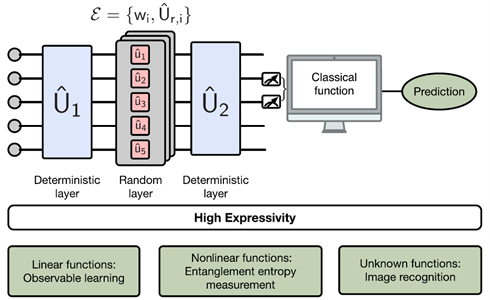2024-07-03
The team of Professor Xiaopeng Li, PI at Shanghai Qi Zhi Institute and professor at Fudan University, has conducted interdisciplinary research between artificial intelligence and quantum many-body dynamics, discovering that the research in both areas promotes each other and complements each other. On one hand, quantum fluctuations and classical fluctuations in quantum dynamical systems provide a new development path for enhancing the expressive power of neural networks. On the other hand, artificial intelligence models trained with data generated by quantum systems have achieved unprecedented results in the measurement of weak forces. The relevant achievements have been published in the renowned academic journals in the field of physics, Phys. Rev. Letters and Communication Physics.
New Quantum Neural Network Structure
To perform general tasks in quantum neural networks, the introduction of nonlinear functions is necessary. Current quantum neural networks are not very good at handling this complexity, which is also a problem that quantum machine learning urgently needs to address. In response to this issue, Li Xiaopeng proposed introducing randomness into quantum neural networks and proposed a new type of quantum neural network structure (Quantum Neural Networks, QNNs), expanding the expressive power of quantum neural networks.
As shown in Figure 1, the gray module is the quantum neural network random layer, composed of a set of trainable random quantum gates; the blue module is the quantum neural network deterministic layer; finally, the measurement results of the quantum neural network are input into a classical function, which is the final output result. Through the action of the random layer, the final output result is the probability superposition of the evolution results of different quantum trajectories, containing more information about the quantum system, thereby accurately predicting the target function.

Figure 1. Schematic diagram of a random quantum circuit
Researchers applied this quantum neural network structure to learning in three different tasks: learning of observable expectation values, learning of subsystem entanglement entropy, and learning for classical image recognition tasks. In these three different learning tasks, the introduction of the random layer significantly enhances the expressive power of the quantum neural network. In the learning task of observable expectation values, for smaller systems, the prediction error of the neural network can reach 10−1010−10. The number of random quantum gates increases sub-exponentially with the system size, indicating that the computational resources required to achieve the same prediction accuracy do not grow exponentially, which is very advantageous for the implementation of quantum machine learning. In the learning task of entanglement entropy, researchers studying single-qubit and two-qubit subsystems found that when the prediction error reaches 10−710−7, the number of random quantum gates is exponentially related to the size of the subsystem with a base of 3, which is much smaller than the size of the Clifford group.
This work studied the potential impact of the random layer on quantum machine learning algorithms, indicating the broad application prospects of quantum neural networks in the field of quantum computing and machine learning. The relevant research results were published in Physical Review Letters 132, 010602 in January 2024. The first author of the paper is Yadong Wu, a part-time researcher at the Shanghai Qi Zhi Institute and a postdoctoral fellow at Fudan University.
For more information, please refer to the paper:
Randomness-enhanced expressivity of quantum neural networks, Yadong Wu, Juan Yao, Pengfei Zhang*, Xiaopeng Li *, Phys. Rev. Letter 132, 010602 (2024)